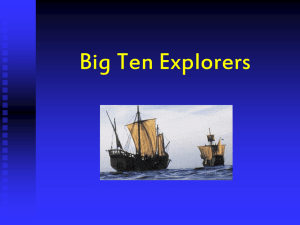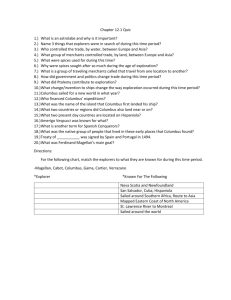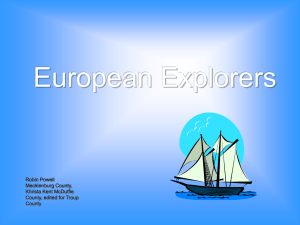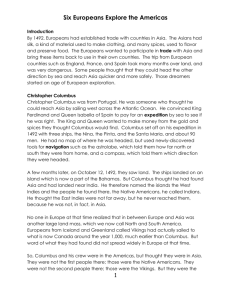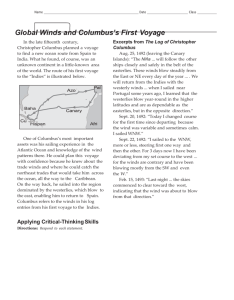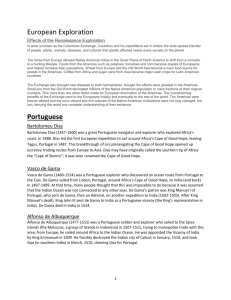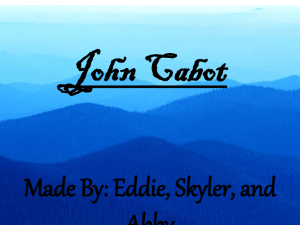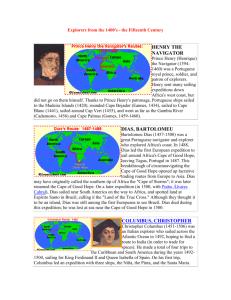Explorer Information
advertisement
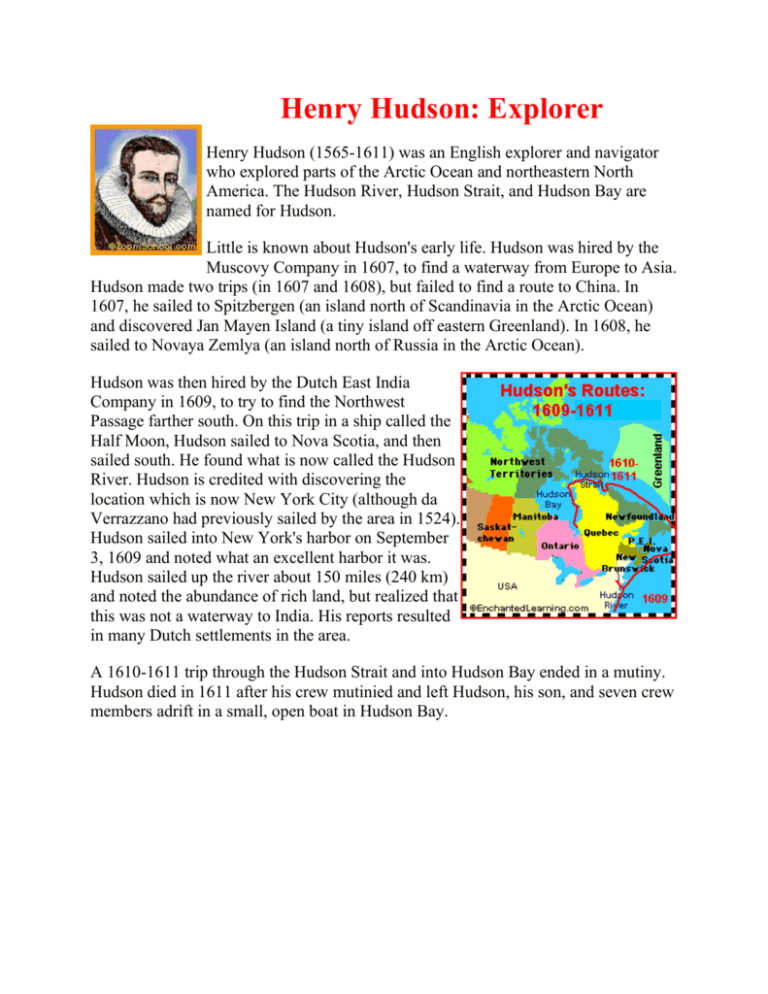
Henry Hudson: Explorer Henry Hudson (1565-1611) was an English explorer and navigator who explored parts of the Arctic Ocean and northeastern North America. The Hudson River, Hudson Strait, and Hudson Bay are named for Hudson. Little is known about Hudson's early life. Hudson was hired by the Muscovy Company in 1607, to find a waterway from Europe to Asia. Hudson made two trips (in 1607 and 1608), but failed to find a route to China. In 1607, he sailed to Spitzbergen (an island north of Scandinavia in the Arctic Ocean) and discovered Jan Mayen Island (a tiny island off eastern Greenland). In 1608, he sailed to Novaya Zemlya (an island north of Russia in the Arctic Ocean). Hudson was then hired by the Dutch East India Company in 1609, to try to find the Northwest Passage farther south. On this trip in a ship called the Half Moon, Hudson sailed to Nova Scotia, and then sailed south. He found what is now called the Hudson River. Hudson is credited with discovering the location which is now New York City (although da Verrazzano had previously sailed by the area in 1524). Hudson sailed into New York's harbor on September 3, 1609 and noted what an excellent harbor it was. Hudson sailed up the river about 150 miles (240 km) and noted the abundance of rich land, but realized that this was not a waterway to India. His reports resulted in many Dutch settlements in the area. A 1610-1611 trip through the Hudson Strait and into Hudson Bay ended in a mutiny. Hudson died in 1611 after his crew mutinied and left Hudson, his son, and seven crew members adrift in a small, open boat in Hudson Bay. Christopher Columbus: Explorer Christopher Columbus (1451-1506) was an Italian explorer who sailed across the Atlantic Ocean in 1492, hoping to find a route to India (in order to trade for spices). He made a total of four trips to the Caribbean and South America during the years 1492-1504. The First Trip: Columbus sailed for King Ferdinand II and Queen Isabella of Spain. On his first trip, Columbus led an expedition with three ships, the Niña (captained by Vicente Yáñez Pinzon), the Pinta (owned and captained by Martin Alonzo Pinzon), and the Santa Maria (captained by Columbus), and about 90 crew members. They set sail on Aug. 3, 1492 from Palos, Spain, and on October 11, 1492, spotted the Caribbean islands off southeastern North America. They landed on an island they called Guanahani, but Columbus later renamed it San Salvador. They were met by the local Taino Indians, many of whom were captured by Columbus' men and later sold into slavery. Columbus thought he had made it to Asia, and called this area the Indies, and called its inhabitants Indians. While exploring the islands in the area and looking for gold to loot, Columbus' men traveled to the islands of Hispaniola (now divided into Haiti and the Dominican Republic), Cuba, and many other smaller islands. On the return trip, the Santa Maria was wrecked and the captain of the Pinta sailed off on his own to try to beat Columbus back. Columbus returned to Spain in the Nina, arriving on March 15, 1493. In 1492, Columbus sailed from Spain with three ships. Two of the ships, the Niña and the Pinta were small caravels. The third ship, the Santa Maria, was a larger type of ship, a carrack, and was captained by Columbus. The ships were from 15 to 36 meters long. The Second Trip: On a second, larger expedition (Sept. 25, 1493-June 11, 1496), sailed with 17 ships and 1,200 to 1,500 men to find gold and capture Indians as slaves in the Indies. Columbus established a base in Hispaniola and sailed around Hispaniola and along the length of southern Cuba. He spotted and named the island of Dominica on November 3, 1493. The Third Trip: On a third expedition (May 30, 1498-October 1500), Columbus sailed farther south, to Trinidad and Venezuela (including the mouth of the Orinoco River). Columbus was the first European since the Viking Leif Ericsson to set foot on the mainland of America. Captain Christopher Columbus' ensign (banner) pictured a cross and the crown-topped initials F (for King Ferdinand of Spain) and Y (for Queen Isabella of Spain). The Fourth Trip: On his fourth and last expedition (May 9, 1502-Nov. 7, 1504), Columbus sailed to Mexico, Honduras and Panama (in Central America) and Santiago (Jamaica). Columbus is buried in eastern Hispaniola (now called the Dominican Republic). VERRAZZANO, GIOVANNI DA Giovanni da Verrazzano (1485-1528) was an Italian navigator who, in 1524, explored the northeast coast of North America from Cape Fear, North Carolina to Maine while searching for a Northwest passage to Asia. Verrazzano sailed for King François-premier (Francis I) of France. Verrazzano's brother, Girolamo da Verrazzano, was a mapmaker who accompanyed Giovanni on his voyage, and mapped the voyage. Verrazzano left Madeira, Spain, on January 17, 1524, and landed at Cape Fear on March 1. He first sailed south, then returned and sailed north, to New York, anchoring the narrows that are now name for him. He sailed up to Maine and then on to New Foundland, Canada, and back to Europe (landing in Dieppe, France on July 8). Verrazzano thought that North America was a thin isthmus separating the Atlantic and Pacific Oceans. Verrazzano was killed and eaten by Carib Indians in 1528. The Verrazzano Narrows Bridge, a suspension bridge that spans New York Harbor, connecting Brooklyn and Staten Island (New York, USA), was named for Verrazzano. Juan Ponce de Leon: Explorer Juan Ponce de Leon (1460?-1521) was a Spanish explorer and soldier who was the first European to set foot in Florida. He also established the oldest European settlement in Puerto Rico and discovered the Gulf Stream (a current in the Atlantic Ocean). Ponce de Leon was searching for the legendary fountain of youth and other riches. Born in Santervas, Spain, in 1460 (the date is uncertain), Ponce de Leon was a soldier fighting Muslims in southern Spain in the early 1490's. Ponce de Leon sailed on Christopher Columbus' second expedition to the Americas in 1493. Ponce de Leon did not return to Spain with Columbus; he stayed in Santo Domingo (now called the Dominican Republic). He was appointed governor of the Dominican province of Higuey. He later heard of gold in the neighboring island of Borinquen (now called Puerto Rico) and brutally conquered the island, claiming it for Spain. He was then appointed governor of this island. Due to his extreme brutality to Native Americans, he was removed from office in 1511. Ponce de Leon was then given the right to find and take the island of Bimini (in the Bahamas); he was searching for riches and the fountain of youth (a legendary spring that gave people eternal life and health). He sailed from Puerto Rico on March 3, 1513, with three ships, the Santa Maria, the Santiago, and the San Cristobal, and about 200 men. After stops at Grand Turk Island and San Salvador, they reached the east coast of Florida (St. Augustine) in April 1513. Ponce de Leon named the land "Pascua de Florida" (feast of flowers) because they first spotted land on April 2, 1513, Palm Sunday. He then claimed the land for Spain. They left on April 8, heading south in the warm current now known as the Gulf Stream. This oceanic current would become very important for Spanish trips from Europe to America. On the return trip, a fight broke out between Ponce de Leon's men and Native Americans in southern Florida. They sailed to Cuba, then headed north, again trying to find Bimini (but instead, finding Andros Island). After returning to Puerto Rico, Ponce de Leon resumed fighting with the Native Americans (putting down their rebellions against Spanish rule). He returned to Spain and was named a Captain General by the King of Spain on September 27, 1514, and again sailed to Puerto Rico to search for the elusive Bimini. His last expedition was another search for Bimini in 1521. His force of 200 men landed on the west coast of Florida, but were met by Native American warriors, who wounded many of the men with arrows, including Ponce de Leon. Ponce de Leon later died in Havana, Cuba, from this wound (in July, 1521). He is buried in San Juan, Puerto Rico. John Cabot: Explorer John Cabot (about 1450-1499) was an Italian-born English explorer and navigator. In Italy, he is known as Giovanni Caboto (which is his original name). Cabot was born in Italy but moved to England in 1495. At the request of King Henry VII of England, Cabot sailed to Canada in 1497, commanding the small ship called "Matthew." Cabot landed near Labrador, Newfoundland, or Cape Breton Island (the exact spot is uncertain) on June 24, 1497. One of John Cabot's three sons, the explorer Sebastian Cabot, accompanied him on this trip. Cabot claimed the land for England. Cabot explored the Canadian coastline and named many of its islands and capes. The mission's purpose was to search for a Northwest passage across North America to Asia (a seaway to Asia). Cabot was unsuccessful, although he thought that he had reached northeastern Asia. Cabot undertook a second, larger expedition in 1498. On this trip, Cabot may have reached America, but that is uncertain. Cabot's expeditions were the first of Britain's claims to Canada. John Cabot died in England in 1499. Hernando De Soto: Explorer Hernando De Soto (1500?-1542) was a Spanish explorer who sailed the Atlantic Ocean and was the first European to explore Florida and the southeastern US. De Soto was born in the Spanish province of Extremadura (near Portugal). In 1524, he went on an expedition to Nicaragua, South America, with Francisco de Cordoba. De Soto sided with Pedro Arias de Ávila (also called Pedrarias Dávila) against Cordoba (who had tried to claim land for himself), and Cordoba was killed. De Soto lived for a while in Nicaragua, prospering by engaging in the slave trade. Francisco Pizarro enlisted de Soto for an expedition to Peru (1531-1532). During this expedition they met and killed Atahualpa, the ruler of the Incas, and conquered the Inca empire. De Soto returned to Spain in 1536, and was granted the rights to conquer Florida and was named governor of Cuba in 1537. De Soto arrived on the west coast of Florida on May 30, 1539 with 10 ships carrying over 600 soldiers, priests, and explorers. They spent four years searching for gold and silver, exploring the area, and brutally contacting native societies, including the Cherokees, Seminoles, Creeks, Appalachians, and Choctaws. De Soto died during the explorations and was buried on the banks of the Mississippi River in late June, 1542. Alvar Nunez Cabeza de Vaca: Explorer Alvar Nuñez Cabeza de Vaca [Cabeza de Vaca means "head of a cow"] (1490?1557?) was a Spanish explorer who sailed to North America from Spain, leaving in 1527. The expedition of 250 to 300 men was led by Panfilo de Narvaez. After surviving a hurricane near Cuba, the expedition landed on the west coast of Florida (near Tampa Bay) in April 1528, claiming the land for Spain. A series of hurricanes and fights with Native Americans killed many of the crew, and the pilot of the ship sailed to Mexico without the 250 to 300 men. The stranded men hastily made 5 make-shift rafts on which they sailed west, hoping to reach a Spanish settlement in Mexico. Three rafts sank, but the two surviving rafts (carrying 80 men) landed at Galveston Island (off what is now Texas). Narvaez did not survive. After a very cold winter with very little food, only 15 men survived. In spring, the men traveled west by land, walking along the Colorado River. By 1533, there were only four survivors, including Estevanico, Carranza, Cabeza de Vaca, and Alonso Castillo Maldonado. The men were enslaved for a while by some Indian tribes along the way, and were helped by other tribes. They were the first non-natives to travel in this area of the southwestern North America. Da vaca and his fellow travelers were the first Europeans to see the bison, or American buffalo. The four men finally reached the Spanish settlement of Culiacan in early 1536 (8 years after being stranded in Florida). Later that year they reached Mexico City, where they were welcomed by the Viceroy Antonio de Mendoza. After serving as a Mexican territorial governor, Cabeza de Vaca returned to Spain (in 1537) and published an account of his travels, noting the appalling treatment of Indians by the Spanish. His writing encouraged many other Spanish expeditions to the Americas, including those of Hernando de Soto and Francisco Vasquez de Coronado. In 1540, Cabeza de Vaca was appointed governor of the Spanish settlement on the Rio de la Plata (now called Paraguay). He explored along the Paraguay River (in 1542, he was the first European to see Iguacu Falls). The settlers threw him out of office in 1545, and he was put on trial - he was charged with many offenses, including usurping the authority of the King of Spain. He was found guilty and died soon after. Francisco Vasquez de Coronado: Explorer and Conquistador Francisco Vásquez de Coronado (1510-1554) was a Spanish ruler, explorer and conquistador. He was the first European to explore North America's Southwest. Coronado was a governor of New Galicia, a western province of Mexico. He searched fruitlessly for treasure that was rumored to exist in northern Mexico: the fabled seven Golden Cities of Cibola. With a group of hundreds of Spaniards and enslaved natives, he traveled through what is now northern Mexico and the southwestern USA (including Arizona, New Mexico, Texas, Oklahoma, and Kansas). His expedition found only Zuñi, Hopi, and Pueblos, native Americans who repelled Coronado when he demanded that they convert to Christianity. Coronado killed many native Americans during this expedition. Since he did not find gold, silver, or other treasures, his expedition was branded a failure by Spanish leaders.
